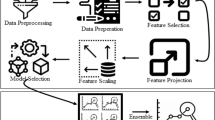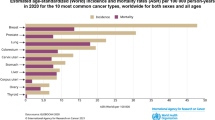Abstract
Breast cancer is a divergent and prominent cancer that is responsible for the morbidity and mortality of women throughout the world. This paper aims at early detection and accurate diagnosis of this fatal disease, which is one of the most important steps in breast cancer treatment. Therefore, various nested ensemble machine learning techniques are used to help doctors determine breast cancer at an early stage. The two-layer nested ensemble model has been proposed, which encompasses stacking and voting techniques to detect benign and malignant breast cancer tumors. A total of four two-layer nested ensemble models have been proposed. S(NaiveBayes)-V(3-Meta_Learner), S(BayesNet)-V(3-Meta_Learner), S(NaiveBayes)-V(4-Meta_Learner), and S(BayesNet)-V(4-Meta_Learner) have been designed to contain base learners and meta learners. The experiments have been conducted with the k-fold cross-validation technique for model evaluation. The proposed model is capable of classifying benign and malignant breast cancer tumors with 99.50% accuracy. The aforementioned four models have been compared with previous works in terms of classification accuracy, ROC, recall, precision, TP rate, FP rate, and F1 measure. The experiments showed that the proposed two-layer nested ensemble model S(BayesNet)-V(4-Meta_Learner) performed better than the other three models mentioned supra and competed with all the previously published works. This would help the scientific community and health practitioners diagnose breast cancer with early and accurate results.







Similar content being viewed by others
REFERENCES
Dora, L., Agrawal, S., Panda, R., and Abraham, A., Optimal breast cancer classification using Gauss–Newton representation based algorithm, Expert Syst. Appl., 2017, vol. 85, pp. 134–145. https://doi.org/10.1016/j.eswa.2017.05.035
Zheng, B., Yoon, S.W., and Lam, S.S., Breast cancer diagnosis based on feature extraction using a hybrid of K-means and support vector machine algorithms, Expert Syst. Appl., 2014, vol. 41, no. 4, pp. 1476–1482. https://doi.org/10.1016/j.eswa.2013.08.044
Chen, Ch.-H., A hybrid intelligent model of analyzing clinical breast cancer data using clustering techniques with feature selection, Appl. Soft Comput., 2014, vol. 20, pp. 4–14. https://doi.org/10.1016/j.asoc.2013.10.024
Muto, T., Bussey, H.J.R., and Morson, B.C., The evolution of cancer of the colon and rectum, Cancer, 1975, vol. 36, no. 6, pp. 2251–2270. https://doi.org/10.1002/cncr.2820360944
Bhardwaj, A. and Tiwari, A., Breast cancer diagnosis using Genetically Optimized Neural Network model, Expert Syst. Appl., 2015, vol. 42, no. 10, pp. 4611–4620. https://doi.org/10.1016/j.eswa.2015.01.065
Okagbue, H.I., Adamu, P.E., Oguntunde, P.E., Obasi, E.C.M., and Odetunmibi, O.A., Machine learning prediction of breast cancer survival using age, sex, length of stay, mode of diagnosis and location of cancer, Health Technol., 2021, vol. 11, no. 4, pp. 887–893. https://doi.org/10.1007/s12553-021-00572-4
Zhou, Ch.-M., Xue, Q., Wang, Yi., Tong, J., Ji, M., and Yang, J.-J., Machine learning to predict the cancer-specific mortality of patients with primary non-metastatic invasive breast cancer, Surg. Today, 2021, vol. 51, no. 5, pp. 756–763. https://doi.org/10.1007/s00595-020-02170-9
Globocan IAC, Globocan 2018: India factsheet—India Against Cancer, ICMR, 2022. http://cancerindia. org.in/globocan-2018-india-factsheet/. Cited July 16, 2022.
Christoyianni, I., Dermatas, E., and Kokkinakis, G., Fast detection of masses in computer-aided mammography, IEEE Signal Process. Mag., 2000, vol. 17, no. 1, pp. 54–64. https://doi.org/10.1109/79.814646
Elmore, J.G., Wells, C.K., Lee, C.H., Howard, D.H., and Feinstein, A.R., Variability in radiologists' interpretations of mammograms, New Engl. J. Med., 1994, vol. 331, no. 22, pp. 1493–1499. https://doi.org/10.1056/nejm199412013312206
Acharya, U.R., Ng, W.L., Rahmat, K., Sudarshan, V.K., Koh, J.E.W., Tan, J.H., Hagiwara, Yu., Yeong, Ch.H., and Ng, K.H., Data mining framework for breast lesion classification in shear wave ultrasound: A hybrid feature paradigm, Biomed. Signal Process. Control, 2017, vol. 33, pp. 400–410. https://doi.org/10.1016/j.bspc.2016.11.004
Kong, H., Lai, Z., Wang, X., and Liu, F., Breast cancer discriminant feature analysis for diagnosis via jointly sparse learning, Neurocomputing, 2016, vol. 177, pp. 198–205. https://doi.org/10.1016/j.neucom.2015.11.033
Örkcü, H.H. and Bal, H., Comparing performances of backpropagation and genetic algorithms in the data classification, Expert Syst. Appl., 2011, vol. 38, no. 4, pp. 3703–3709. https://doi.org/10.1016/j.eswa.2010.09.028
Breast cancer facts and statistics, Breast Cancer Care, 2022. https://www.breastcancer.org/facts-statistics. Cited July 19, 2022.
Goodman, D.E., Boggess, L.C., and Watkins, A.B., Artificial immune system classification of multiple-class problems, Proc. Intell. Eng. Syst., 2022, vol. 12, pp. 179–184. https://www.semanticscholar.org/paper/artificial-immune-system-classification-of-multiple-Goodman-Boggess/4b0a63a93b6b1b9c19c83c31f163569320352b3d.
Cevikalp, H., Triggs, B., Yavuz, H.S., Küçük, Ya., Küçük, M., and Barkana, A., Large margin classifiers based on affine hulls, Neurocomputing, 2010, vol. 73, nos. 16–18, pp. 3160–3168. https://doi.org/10.1016/j.neucom.2010.06.018
Li, D.-Ch. and Liu, Ch.-W., A class possibility based kernel to increase classification accuracy for small data sets using support vector machines, Expert Syst. Appl., 2010, vol. 37, no. 4, pp. 3104–3110. https://doi.org/10.1016/j.eswa.2009.09.019
Stoean, R. and Stoean, C., Modeling medical decision making by support vector machines, explaining by rules of evolutionary algorithms with feature selection, Expert Syst. Appl., 2013, vol. 40, no. 7, pp. 2677–2686. https://doi.org/10.1016/j.eswa.2012.11.007
Koloseni, D. and Luukka, P., Differential evolution based nearest prototype classifier with optimized distance measures and GOWA, Intelligent Systems’2014, Angelov, P. et al., Eds., Advances in Intelligent Systems and Computing, vol. 322, Cham: Springer, 2014, pp. 753–763. https://doi.org/10.1007/978-3-319-11313-5_66
Chen, H.L., Yang, B., Wang, S., Wang, G., Liu, D.Yo., Li, H.Zh., and Liu, W.B., Towards an optimal support vector machine classifier using a parallel particle swarm optimization strategy, Appl. Math. Comput., 2014, vol. 239, pp. 180–197. https://doi.org/10.1016/j.amc.2014.04.039
Wang, H., Zheng, B., Yoon, S.W., and Ko, H.S., A support vector machine-based ensemble algorithm for breast cancer diagnosis, Eur. J. Oper. Res., 2018, vol. 267, no. 2, pp. 687–699. https://doi.org/10.1016/j.ejor.2017.12.001
Wang, D., Wan, S., and Guizani, N., Context-based probability neural network classifiers realized by genetic optimization for medical decision making, Multimedia Tools Appl., 2018, vol. 77, no. 17, pp. 21995–22006. https://doi.org/10.1007/s11042-018-5631-3
Huang, M.-W., Chen, Ch.-W., Lin, W.-Ch., Ke, Sh.-W., and Tsai, Ch.-F., SVM and SVM ensembles in breast cancer prediction, PLoS ONE, 2017, vol. 12, no. 1, p. e0161501. https://doi.org/10.1371/journal.pone.0161501
Rosales-Pérez, A., Escalante, H.J., Gonzalez, J.A., Reyes-Garcia, C., and Coello Coello, C.A., Bias and variance multi-objective optimization for support vector machines model selection, Pattern Recognition and Image Analysis. IbPRIA, Sanches, J.M., Micó, L., and Cardoso, J.S., Eds., Lecture Notes in Computer Science, vol. 7887, Berlin: Springer, 2013, pp. 108–116. https://doi.org/10.1007/978-3-642-38628-2_12
Hassan, A.R. and Hassan Bhuiyan, M.I., Automatic sleep scoring using statistical features in the EMD domain and ensemble methods, Biocybernetics Biomed. Eng., 2016, vol. 36, no. 1, pp. 248–255. https://doi.org/10.1016/j.bbe.2015.11.001
Hassan, A.R., Computer-aided obstructive sleep apnea detection using normal inverse Gaussian parameters and adaptive boosting, Biomed. Signal Process. Control, 2016, vol. 29, pp. 22–30. https://doi.org/10.1016/j.bspc.2016.05.009
Ting, K.M. and Witten, I.H., Issues in stacked generalization, J. Artif. Intell. Res., 1999, vol. 10, pp. 271–289. https://doi.org/10.1613/jair.594
Witten, I.H., Frank, E., and Hall, M.A., Data Mining: Practical Machine Learning Tools and Techniques, Amsterdam: Elsevier Science, 2005, 2nd ed.
Džeroski, S. and Ženko, B., Is combining classifiers with stacking better than selecting the best one?, Mach. Learn., 2004, vol. 54, no. 3, pp. 255–273. https://doi.org/10.1023/b:mach.0000015881.36452.6e
Ram, S. and Gupta, S., Building machine learning based diseases diagnosis system considering various features of datasets, Emerging Trends in Expert Applications and Security, Rathore, V., Worring, M., Mishra, D., Joshi, A., and Maheshwari, S., Eds., Advances in Intelligent Systems and Computing, vol. 841, Singapore: Springer, 2019, pp. 147–155. https://doi.org/10.1007/978-981-13-2285-3_19
Mihaylov, I., Nisheva, M., and Vassilev, D., Machine learning techniques for survival time prediction in breast cancer, Artificial Intelligence: Methodology, Systems, and Applications, Agre, G., van Genabith, J., and Declerck, T., Eds., Lecture Notes in Computer Science, vol. 11089, Cham: Springer, 2018, pp. 186–194. https://doi.org/10.1007/978-3-319-99344-7_17
Selvathi, D. and Aarthy Poornila, A., Deep learning techniques for breast cancer detection using medical image analysis, Biologically Rationalized Computing Techniques for Image Processing Applications, Hemanth, J. and Balas, V., Eds., Lecture Notes in Computational Vision and Biomechanics, vol. 25, Cham: Springer, 2018, pp. 159–186. https://doi.org/10.1007/978-3-319-61316-1_8
Li, X., Qin, G., He, Q., Sun, L., Zeng, H., He, Z., Chen, W., Zhen, X., and Zhou, L., Digital breast tomosynthesis versus digital mammography: Integration of image modalities enhances deep learning-based breast mass classification, Eur. Radiology, 2020, vol. 30, no. 2, pp. 778–788. https://doi.org/10.1007/s00330-019-06457-5
Chougrad, H., Zouaki, H., and Alheyane, O., Deep convolutional neural networks for breast cancer screening, Comput. Methods Programs Biomedicine, 2018, vol. 157, pp. 19–30. https://doi.org/10.1016/j.cmpb.2018.01.011
Kate, R.J. and Nadig, R., Stage-specific predictive models for breast cancer survivability, Int. J. Med. Inf., 2017, vol. 97, pp. 304–311. https://doi.org/10.1016/j.ijmedinf.2016.11.001
Asri, H., Mousannif, H., Al Moatassime, H., and Noel, T., Using machine learning algorithms for breast cancer risk prediction and diagnosis, Procedia Comput. Sci., 2016, vol. 83, pp. 1064–1069. https://doi.org/10.1016/j.procs.2016.04.224
Samala, R.K., Chan, H.-P., Hadjiiski, L., Helvie, M.A., Richter, C.D., and Cha, K.H., Breast cancer diagnosis in digital breast tomosynthesis: Effects of training sample size on multi-stage transfer learning using deep neural nets, IEEE Trans. Med. Imaging, 2019, vol. 38, no. 3, pp. 686–696. https://doi.org/10.1109/tmi.2018.2870343
U.I.M.L. Repository, Machine Learning Repository, 2010. http://archive.ics.uci.edu/ml/index.php. Cited July 19, 2022.
Shukla, S., Jain, P.K., Babu, Ch.R., and Pamula, R., A multivariate regression model for identifying, analyzing and predicting crimes, Wireless Personal Commun., 2020, vol. 113, no. 4, pp. 2447–2461. https://doi.org/10.1007/s11277-020-07335-w
Friedman, N., Geiger, D., and Goldszmidt, M., Bayesian network classifiers, Mach. Learn., 1997, vol. 29, no. 2/3, pp. 131–163. https://doi.org/10.1023/a:1007465528199
Shastri, S., Kour, P., Kumar, S., Singh, K., Sharma, A., and Mansotra, V., A nested stacking ensemble model for predicting districts with high and low maternal mortality ratio (MMR) in India, Int. J. Inf. Technol., 2021, vol. 13, no. 2, pp. 433–446. https://doi.org/10.1007/s41870-020-00560-3
Saito, T. and Rehmsmeier, M., The precision-recall plot is more informative than the ROC plot when evaluating binary classifiers on imbalanced datasets, PLoS ONE, 2015, vol. 10, no. 3, p. e0118432. https://doi.org/10.1371/journal.pone.0118432
Abdar, M., Zomorodi-Moghadam, M., Zhou, X., Gururajan, R., Tao, X., Barua, P., and Gururajan, R., A new nested ensemble technique for automated diagnosis of breast cancer, Pattern Recognit. Lett., 2020, vol. 132, pp. 123–131. https://doi.org/10.1016/j.patrec.2018.11.004
Lu, H., Wang, H., and Yoon, S.W., A dynamic gradient boosting machine using genetic optimizer for practical breast cancer prognosis, Expert Syst. Appl., 2019, vol. 116, pp. 340–350. https://doi.org/10.1016/j.eswa.2018.08.040
Maglogiannis, I., Zafiropoulos, E., and Anagnostopoulos, I., An intelligent system for automated breast cancer diagnosis and prognosis using SVM based classifiers, Appl. Intell., 2009, vol. 30, no. 1, pp. 24–36. https://doi.org/10.1007/s10489-007-0073-z
Sáez, J., Derrac, J., Luengo, J., and Herrera, F., Statistical computation of feature weighting schemes through data estimation for nearest neighbor classifiers, Pattern Recognit., 2014, vol. 47, no. 12, pp. 3941–3948. https://doi.org/10.1016/j.patcog.2014.06.012
Lim, C.K. and Chan, C.S., A weighted inference engine based on interval-valued fuzzy relational theory, Expert Syst. Appl., 2015, vol. 42, no. 7, pp. 3410–3419. https://doi.org/10.1016/j.eswa.2014.12.025
Aličković, E. and Subasi, A., Breast cancer diagnosis using GA feature selection and Rotation Forest, Neural Comput. Appl., 2017, vol. 28, no. 4, pp. 753–763. https://doi.org/10.1007/s00521-015-2103-9
Nilashi, M., Ibrahim, O., Ahmadi, H., and Shahmoradi, L., A knowledge-based system for breast cancer classification using fuzzy logic method, Telematics Inf., 2017, vol. 34, no. 4, pp. 133–144. https://doi.org/10.1016/j.tele.2017.01.007
Sanchez, A., Soguero-Ruiz, C., Mora-Jiménez, I., Rivas-Flores, F.J., Lehmann, D., and Rubio-Sánchez, M., Scaled radial axes for interactive visual feature selection: A case study for analyzing chronic conditions, Expert Syst. Appl., 2018, vol. 100, pp. 182–196. https://doi.org/10.1016/j.eswa.2018.01.054
Suresh, A. and Varatharajan, R., Recognition of pivotal instances from uneven set boundary during classification, Multimedia Tools Appl., 2018, vol. 77, no. 20, pp. 27075–27088. https://doi.org/10.1007/s11042-018-5905-9
Alshayeji, M.H., Ellethy, H., Abed, S., and Gupta, R., Computer-aided detection of breast cancer on the Wisconsin dataset: An artificial neural networks approach, Biomed. Signal Process. Control, 2022, vol. 71, p. 103141. https://doi.org/10.1016/j.bspc.2021.103141
Sannasi Chakravarthy, S.R., Bharanidharan, N., and Rajaguru, H., Deep learning-based metaheuristic weighted k-nearest neighbor algorithm for the severity classification of breast cancer, IRBM, 2023, vol. 44, no. 3, p. 100749. https://doi.org/10.1016/j.irbm.2022.100749
ACKNOWLEDGMENTS
This research work is dedicated to patients suffering from breast cancer.
Author information
Authors and Affiliations
Corresponding author
Ethics declarations
The authors declare that they have no conflicts of interest.
About this article
Cite this article
Kuljeet Singh, Shastri, S., Kumar, S. et al. BC-Net: Early Diagnostics of Breast Cancer Using Nested Ensemble Technique of Machine Learning. Aut. Control Comp. Sci. 57, 646–659 (2023). https://doi.org/10.3103/S0146411623060093
Received:
Revised:
Accepted:
Published:
Issue Date:
DOI: https://doi.org/10.3103/S0146411623060093




